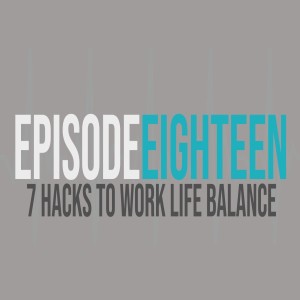
7 Life Hacks to Mastering Work-Life Balance
By Jared Graybeal
I’ve had tons of conversations and read a handful of articles about how there’s no such thing as “work-life balance” if you really want to excel at both. Some say that when it comes to Fitness, Work, Family, Sleep or Friends, you need to pick 3. (1) Others say that when it comes to your health, friends, family or work, one is going to suffer. (2)
While I think it’s impossible to give them all 100% of your energy, because that is physically and mathematically impossible, I still think we can do much better at managing them all and stop making excuses for bad performance at work, lack of presence or commitment in marriage or parenting, no-showing on your friends and not taking care of your health.
Unlike the writers I referenced, I think there are four main quadrants (or “burners”, as James Clear would explain in the below reference) which would be: Family, Business, Health and Hobbies.
In Clear’s explanation of the Four Burner’s Theory, he illustrates a picture of a stovetop where all four burners can’t be going at once. In my opinion, managing these well really looks like an ever-changing, seasonal pie graph, where you expend your energy differently on each thing throughout life. In the poorly drawn, peace-sign-looking illustration below, you’ll see an example of what I mean and how mine is in this season of my life.
I have a small family and no kids or wife, so that quadrant only takes up 10% (or an average of 16 hours a week) of my energy, and it is mainly on investing time with friends, get-togethers, church groups, dating and hanging with my pup. As you can tell, my health (45% or 75 hours a week) and business 35% or 60 hours a week) are the highest priorities in my life, with my hobbies being a much smaller, but still important percentage.
Keep in mind this is going to be different for everyone, so before we get into the life hacks, you need to spend time identifying what your pie graph looks like and understand that this graph will change seasonally, and you need to stay conscious of it.
For example, when I get married and have kids, that part of the graph will grow significantly, and I will have to take away from the others. For you, it might mean that when your kids go off to college, you invest less time on “family” and more time on “hobbies”.
Once you’ve drawn out your graph, these are the 10 life hacks that are going to help you manage your pie graph with excellence:
- Create a time budget (3)
If you begin to value your time like you do your money, you will get a lot more out of it. Identifying that there are 168 hours in every week, and what to do with those hours specifically will allow you to make the proper commitments. Please check out reference 3 for an outline.
- Use a meal prep company
Outsourcing things you don’t enjoy is a key hack that gives you more time in your day. Since most people don’t enjoy cooking a ton of meals in advance, and health should be a priority, using a meal prep company kills two birds with one stone. This would give you more time with friends, or more time with the wife, rather than running through drive-thrus or cooking at home when you’d rather be on the couch, the office or out.
- Outsource work or learn healthy delegation
Most business owners and entrepreneurs I know like to do all the work because they know they do it best and it saves them money. But once you recognize where your energy in your pie chart should be expended, you may see that by hiring others, delegating roles, or researching automation software, you can invest in those other priorities.
- Hire a personal trainer or join a group training facility
We all need to be working out, but most of us don’t have time to draw up a work out plan and spend 2 hours in the gym every day figuring it all out. By hiring a professional or joining a group, you can be in and out in one hour and stay in shape.
- Plan ahead and schedule everything
Even if it’s your work schedule, your daily work out, church on Sundays or picking up the kids, put it all on your calendar. It may seem tedious, but these things all take your time and energy and need to be documented so you know what you can realistically commit to every day/week moving forward.
- Learn to say no
Once you’ve created your pie graph, you should have a better perspective of the things in life you really value. Some of us waste too much time and energy doing things we don’t enjoy or things that don’t add value simply because we don’t know how to politely decline our friends, family and coworkers when they invite us to things or ask us to do things. Please take this into context and know that I am not telling you to tell your wife or your boss no because some things need to be done, but common sense will give you an idea of the things in your life I’m referencing.
- Create a to-don’t list every month
Over time, we accumulate roles, responsibilities and habits that we simply don’t need to be doing anymore. At the end of each month or beginning of each new month, take 1-2 hours to sit, reflect and document the things that have added up in your day-to-day. If you’ve already begun to master 1 through 6, it will be easy to identify how to eliminate the things that will go on your to-don’t list.
I recommend that anytime a major life change happens such as a new job, relationship, move, a new pet, kids, health issue, etc. – you reevaluate your pie graph and adjust accordingly. The key to mastering work-life balance is being proactive about the seasonal changes in your life and always understanding your proper percentages.
- https://www.inc.com/jessica-stillman/work-sleep-family-fitness-or-friends-pick-3.html
- https://jamesclear.com/four-burners-theory
- https://e3biz.com/6-productivity-hacks/
More Episodes
 2021-08-05
2021-08-05
 1.3k
1.3k
 2021-02-28
2021-02-28
 1.3k
1.3k
 2021-01-19
2021-01-19
 658
658
Create your
podcast in
minutes
- Full-featured podcast site
- Unlimited storage and bandwidth
- Comprehensive podcast stats
- Distribute to Apple Podcasts, Spotify, and more
- Make money with your podcast
It is Free
- Privacy Policy
- Cookie Policy
- Terms of Use
- Consent Preferences
- Copyright © 2015-2024 Podbean.com






